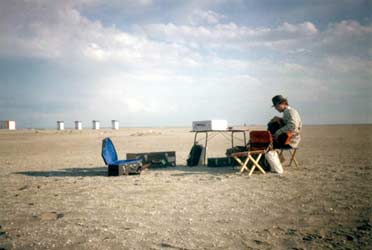

|
Matthias Loibner - Lichtungen


|
|

Matthias Loibner
Hurdy-gurdy master Matthias Loibner is no stranger to pushing the envelope of what his instrument can do. On previous albums such as Zykado and Ajvar & Sterz, Loibner has worked with extended techniques, electronic processing, and musical ideas from well outside the European hurdy-gurdy tradition. Lichtungen continues this exploration. Although Lichtungen opens with a lovely cantabile melody, and uses the counter-rhythms and drones that are associated with the hurdy-gurdy, it is the wide timbral spectrum that grabs and holds the listener's attention. As an expressive arabesque of a melody gives way to gritty, almost Hendrix-like sounds on the second track, "Glutsbruder," a percussive element pops in: the clicks of the hurdy-gurdy keys, right up front in the recording. These clicks spring up throughout the album. Loibner has taken what could be seen as an undesirable artifact of recording his instrument and has turned it into an asset. On the third track, "Folhas Cintilantes," these percussive clicks work as a counterpoint to an otherwise straightforward neoclassical composition.
On the fourth track, appropriately titled "Wings," he manages to incorporate sweeping upward glissandi (how? electronic transformation? Someone tightening the strings as he plays?), leading to some driving rhythms on the trompette and time-stopping hemiolas. His technique extensions frequently left me shaking my head in wonder, as, for instance, in "L'eau dans la Mer," the seventh track, where he coaxes sounds from the hurdy-gurdy that seem almost to be from a glass harmonica.
Further confounding expectations of what a solo hurdy-gurdy album should sound like are evidence of pizzicato techniques, as used extensively on the eighth track, "Kitchen Rain." Is he plucking the strings directly, while regulating the length of the string with the keys (one can clearly hear the keys clicking)? While the more technically obsessed among us might focus on this, it would be a shame to do so at the cost of ignoring the gorgeous melody that Loibner uses this technique on.
As prominent as it is, Loibner's delightful timbral play never comes across as gratuitous, nor does it overshadow his virtuosity on the hurdy-gurdy. These explorations are not gimmicks, but are integral parts of an honest quest. As he has done in his previous work, Loibner is consistently tasteful and deft in his ornamentation, as one would expect from a musician grounded in early music, and his compositions are solid and thoroughly thought out. The tracks are beautifully recorded, allowing the listener to enjoy every tone, every sound, whether it is a pure, flute-like sonority or a creaky scraping of wheel and string. Just the right amount of reverb creates a warm and intimate sound space, perfect for the often meditative nature of these compositions. The packaging, while visually interesting, veers toward the artsy, offering little information. - Erik Keilholtz Read more about the artist in RootsWorld. Watch a video interview with Matthias Loibner, filmed by Michal Shapiro. Another artist who pushes the instrument in new directions is Romain Baudoin and his ensemble Artús.
All music and images ©2015 Matthias Loibner and Traumton.
|
|
|
|